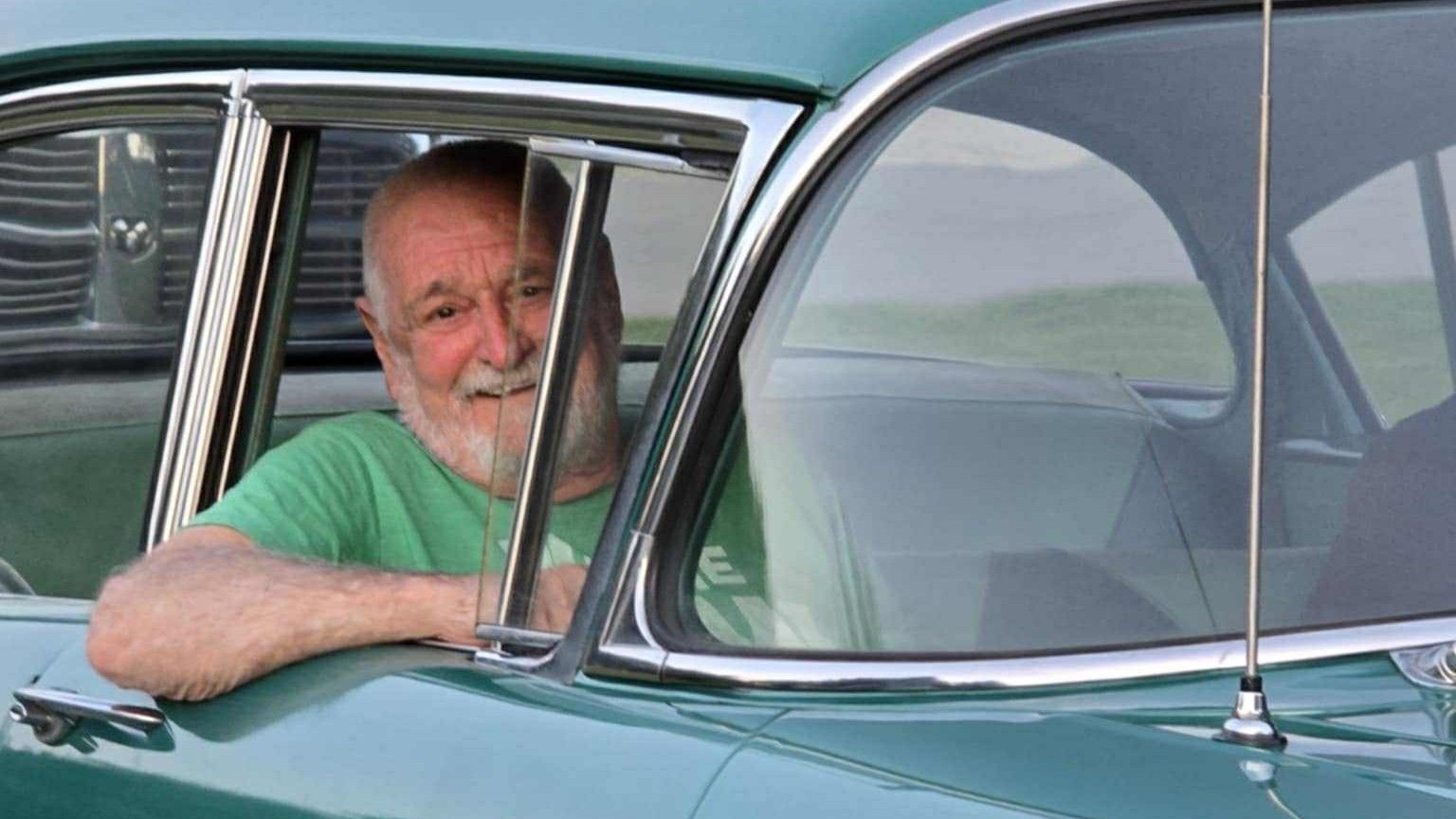Automotive history is a tapestry woven with dreams of the future—some realized, many forever out of reach. Throughout the decades, automakers have unveiled cars meant to redefine how we move, work, and live. These vehicles promised jet-age travel, autonomous journeys, and eco-friendly revolutions. Yet, for every success, there were bold designs that simply didn’t fit the world as it evolved.
Some were just too advanced, others missed the mark due to unpredictable shifts in technology, economics, or culture.
Their stories captivate, reminding us that innovation sometimes outruns reality. The allure of what could have been remains irresistible for car enthusiasts and futurists alike.

The community of Forest Grove, Oregon, came together for its annual Concours d’Elegance on Sunday, July 20, 2025. The event was held on the campus of Pacific University and attracted top-tier vehicles from a wide variety of genres. Hosted by the Rotary Club of Forest Grove, the Concours has become the longest-running event of its kind in the Pacific Northwest—dating all the way back to 1974. Proceeds for the event each year benefit the Rotary Club Foundation scholarships as well as various community service projects. Thanks to the Concours, the Rotary Club has returned more than $1 million to the community over the years.
This year, the Concours attracted over 3,000 patrons to the show field. When they weren’t admiring the automotive eye candy, attendees enjoyed the music, food, beer garden, and wine pavilion on the grounds. And for those who wanted to make an entire weekend of it, there was a vineyard tour and dinner the night prior to the formal show.
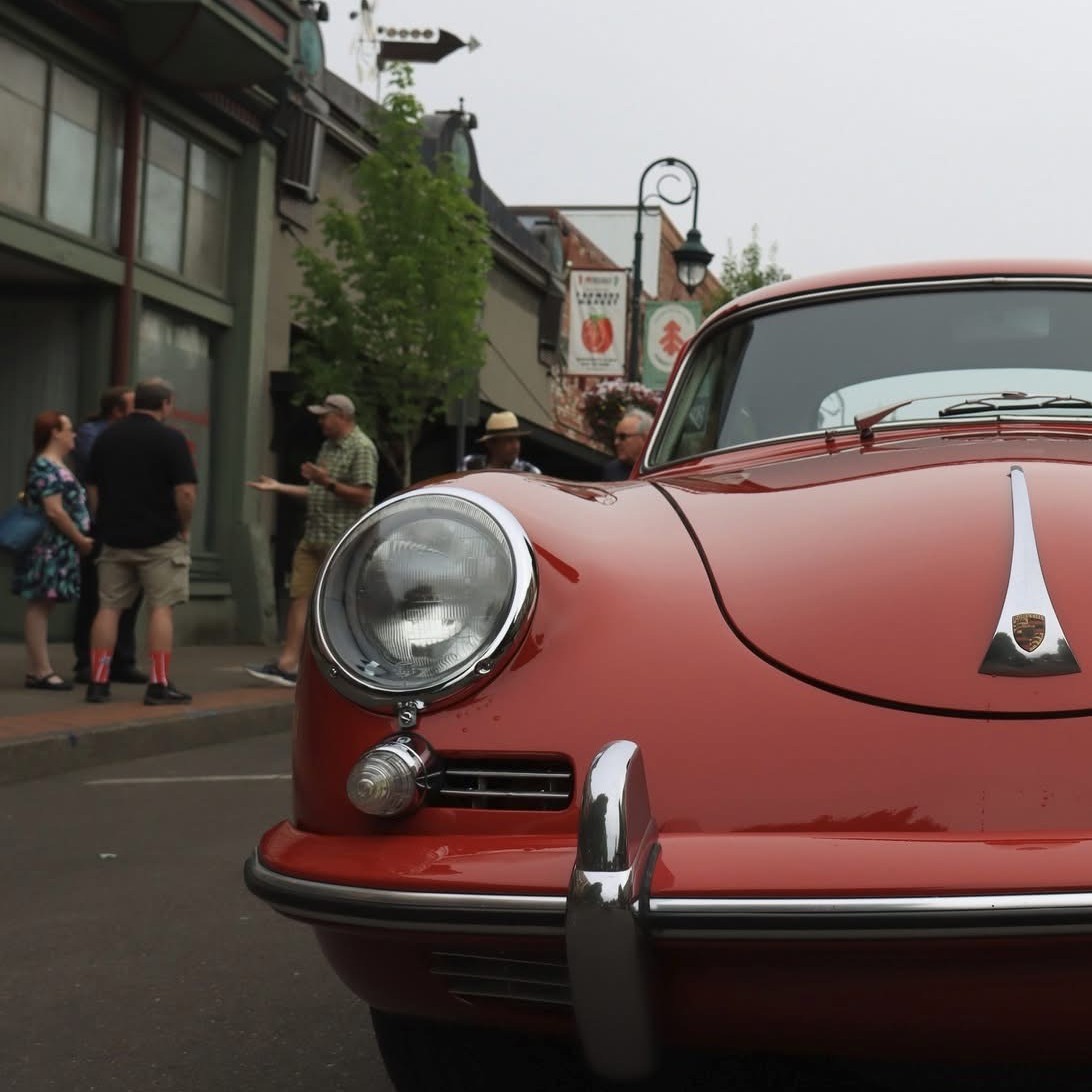
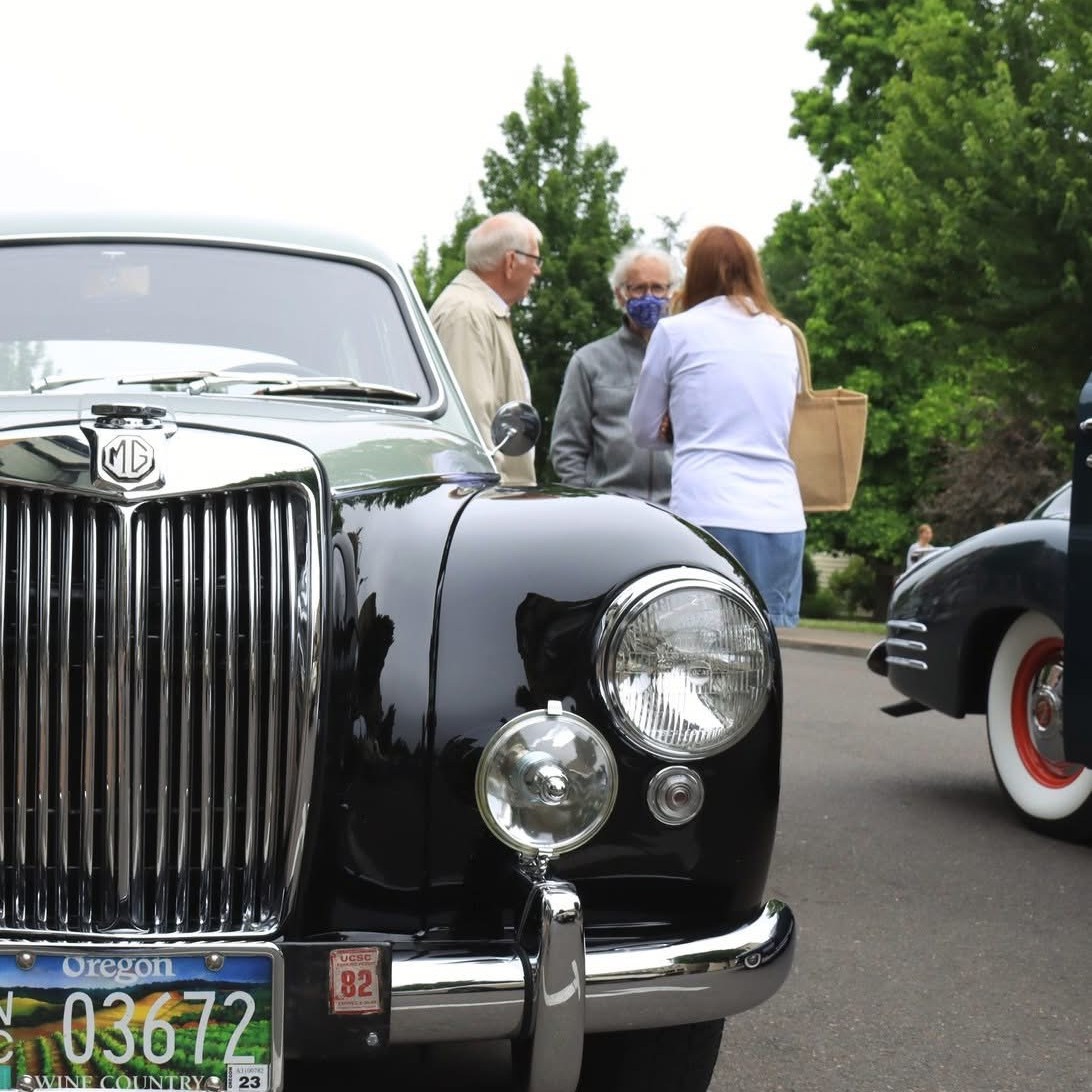
Forest Grove prides itself in having a diverse automotive community, and the Concours made that evident. Virtually every genre was represented. Four of the specific featured classes for 2025 included:
- 50 Years of Turbocharged Porsche (1974 through 2024)
- Air-Cooled Porsche 911 (through 1998)
- 60th Anniversary Shelby Mustang (1965 through 1970)
- Fabulous Fifties
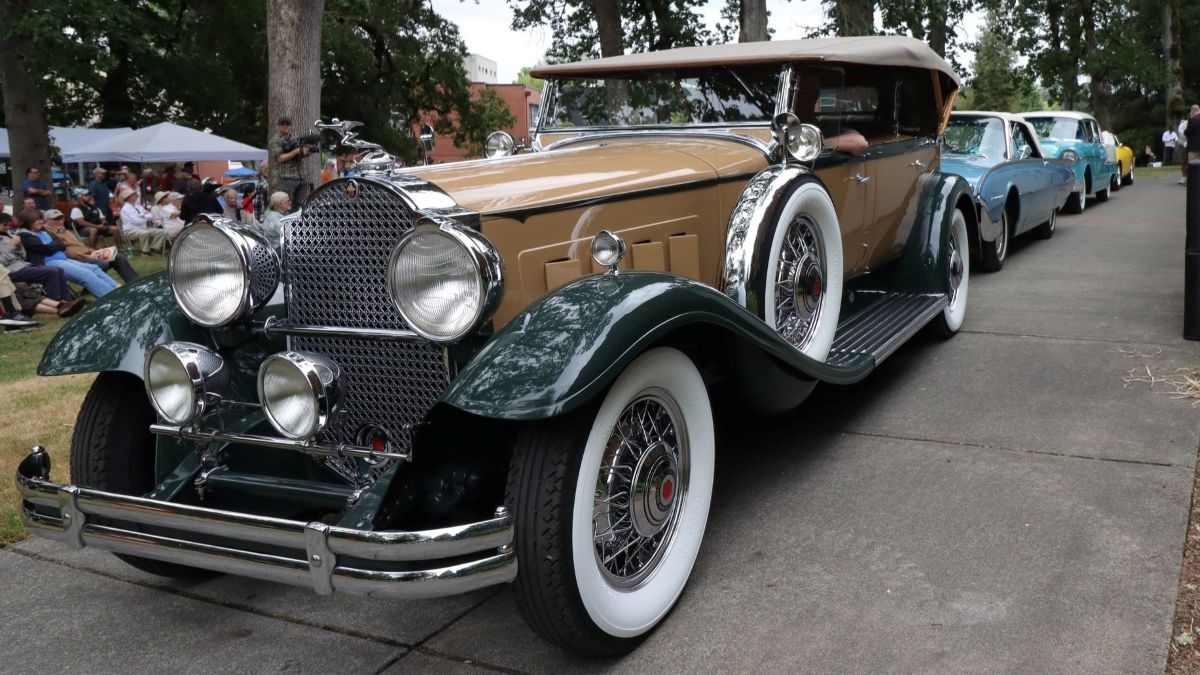
In all, there were about 75 cars judged, and each one had a special story to tell. Some of this year’s standout participants included the following:
- Best of Show went to a stunning 1967 Ferrari 275 GTS/4 NART Spider owned by Fred Russell
- Best Classic Pre-War went to a 1931 Packard 840 Sport Phaeton owned by Dennis Gilman
- Best Open Car went to a 1962 Ford Thunderbird convertible owned by Daniel Cote
- Best Closed Car went to a 1955 Chevrolet Bel Air four-door sedan owned by Keith Lerch
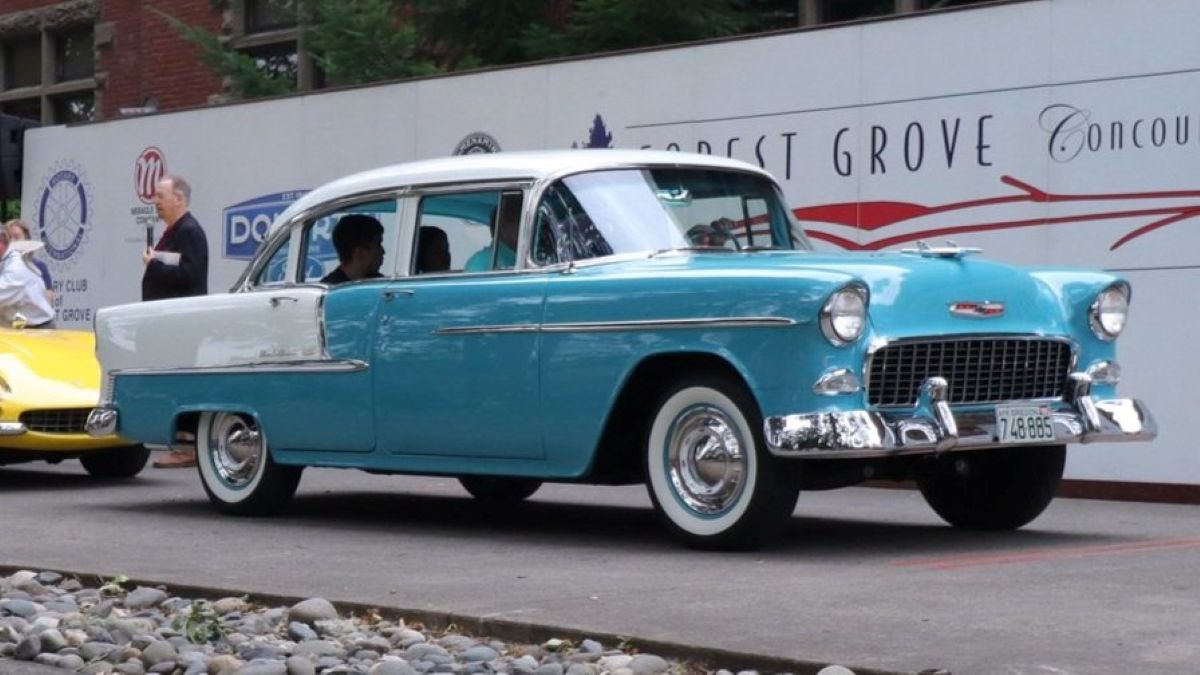
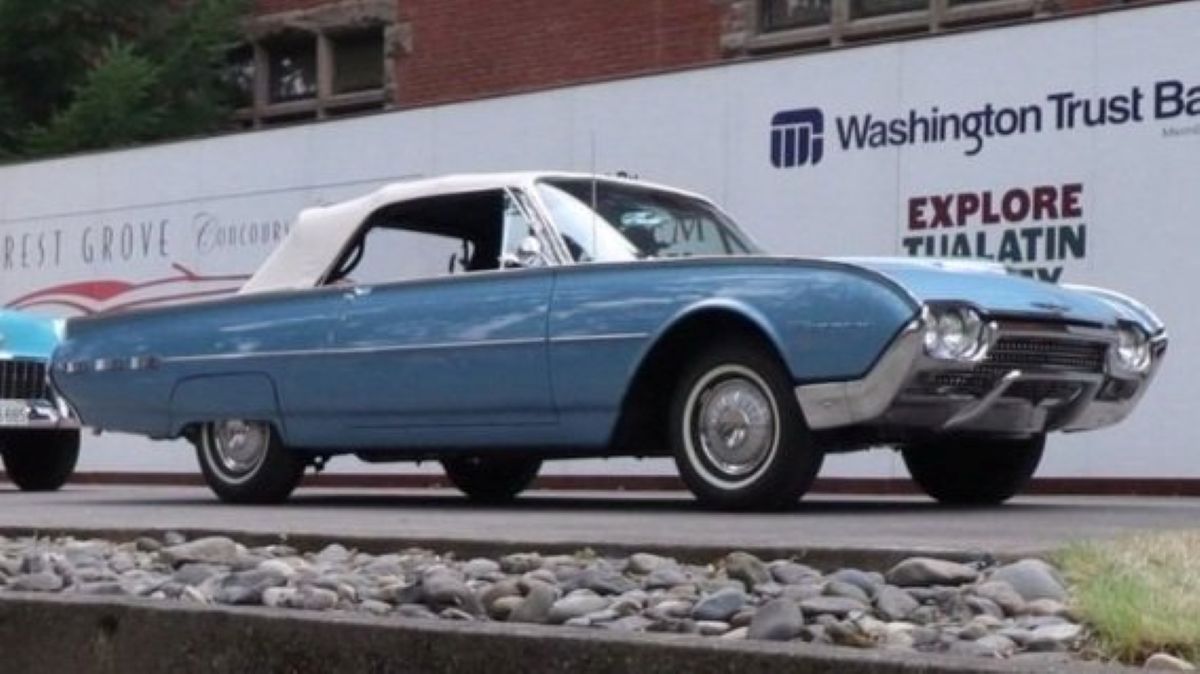
Stay connected to the Forest Hills Concours d’Elegance Facebook page and the official website for updates and announcements about future years events. Next year’s event will be held on July 19, 2026, so mark your calendars, because we look forward to seeing the event’s evolution.
Last September, Nissan revealed the all-new 2025 Armada. The third-generation model ditched the outgoing 5.7-liter V8 for a twin-turbo 3.5-liter V6 paired with a new nine-speed automatic. For the first time ever, the Armada was available in the Pro-4X off-road trim. The 2026 model year brings another first for the Armada: a Nismo variant with more power and a more athletic suspension. However, this broadening of the trim level spectrum is not new for SUVs in general.
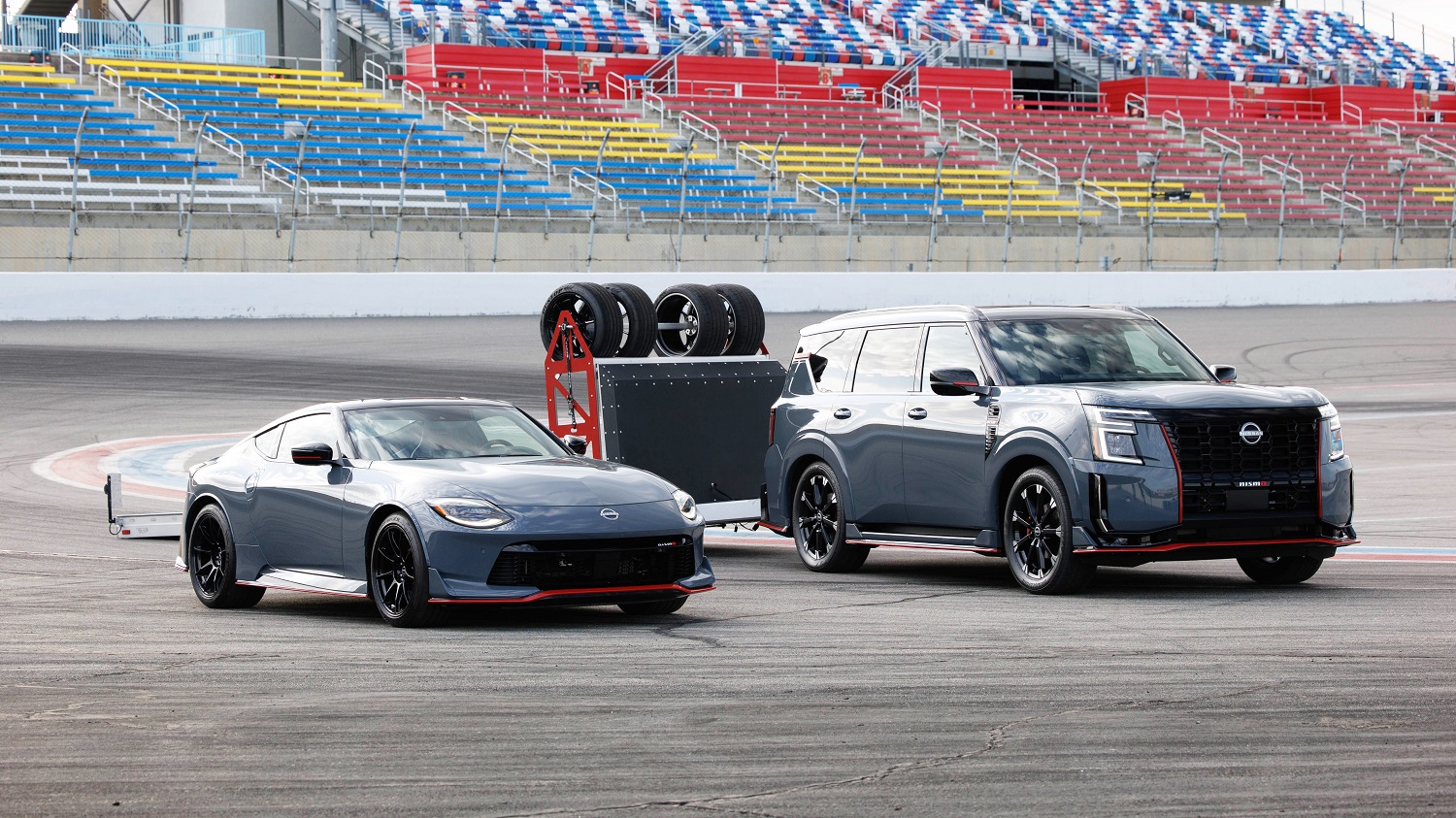
If you’re familiar with Nissan‘s Nismo treatment, which is typically reserved for its sports cars, you know to expect an assortment of cosmetic and performance upgrades. To set the Armada Nismo apart visually from its less sporty siblings, Nismo restyles the 6,102-pound, full-size, body-on-frame SUV’s front and rear fascias, grille, side steps, and rear spoiler. Underneath the fender flares is a set of special 22-inch wheels wrapped in high-performance all-season tires.
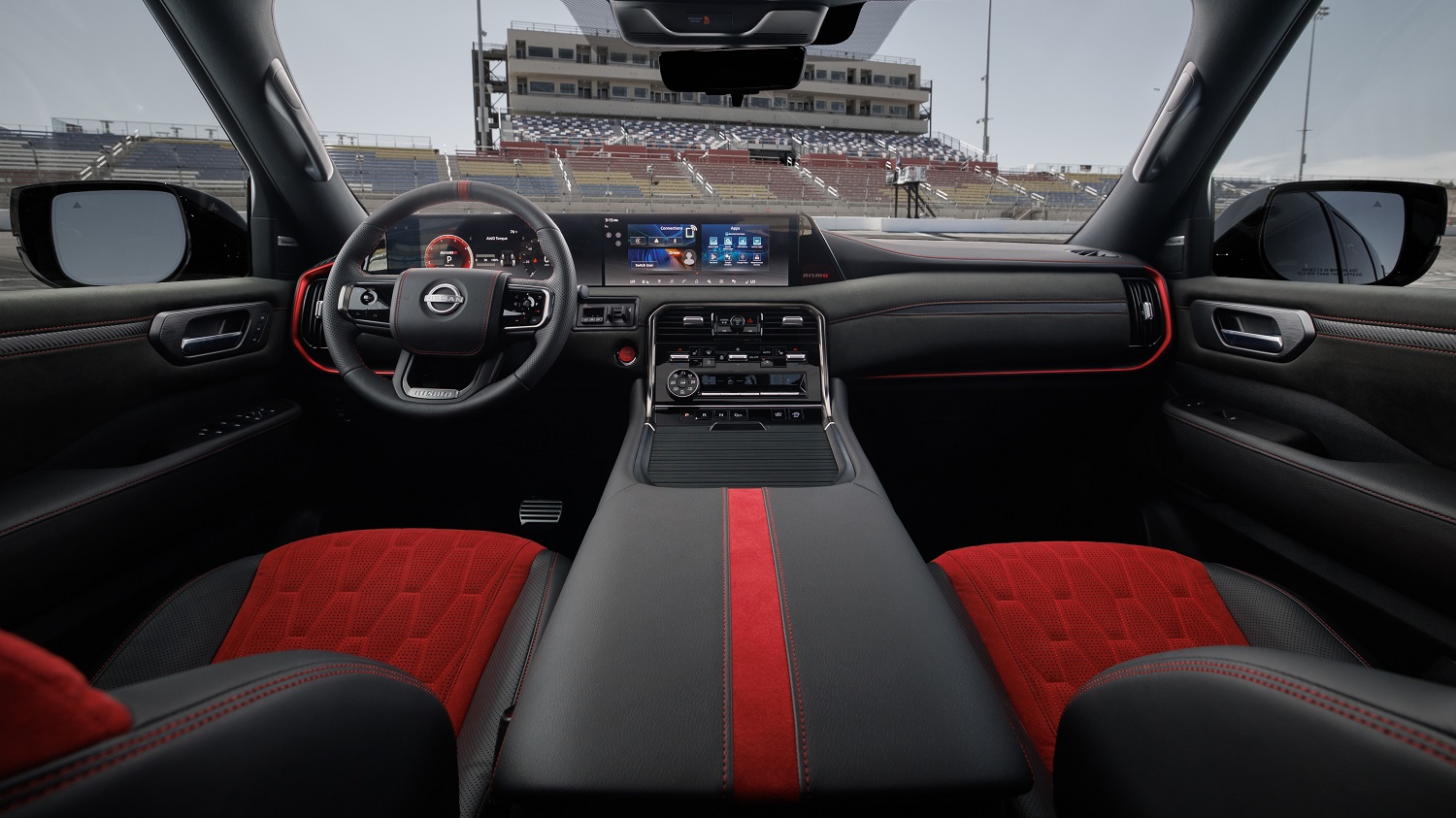
The cabin is similarly distinctive and features Nismo-specific charcoal leather upholstery with quilted red inserts and red stitching. According to Nissan, “Other additions include adjustable side bolsters for the front seats, which help snug occupants in place during spirited driving, plus aluminum pedals and multicolor ambient lighting.”
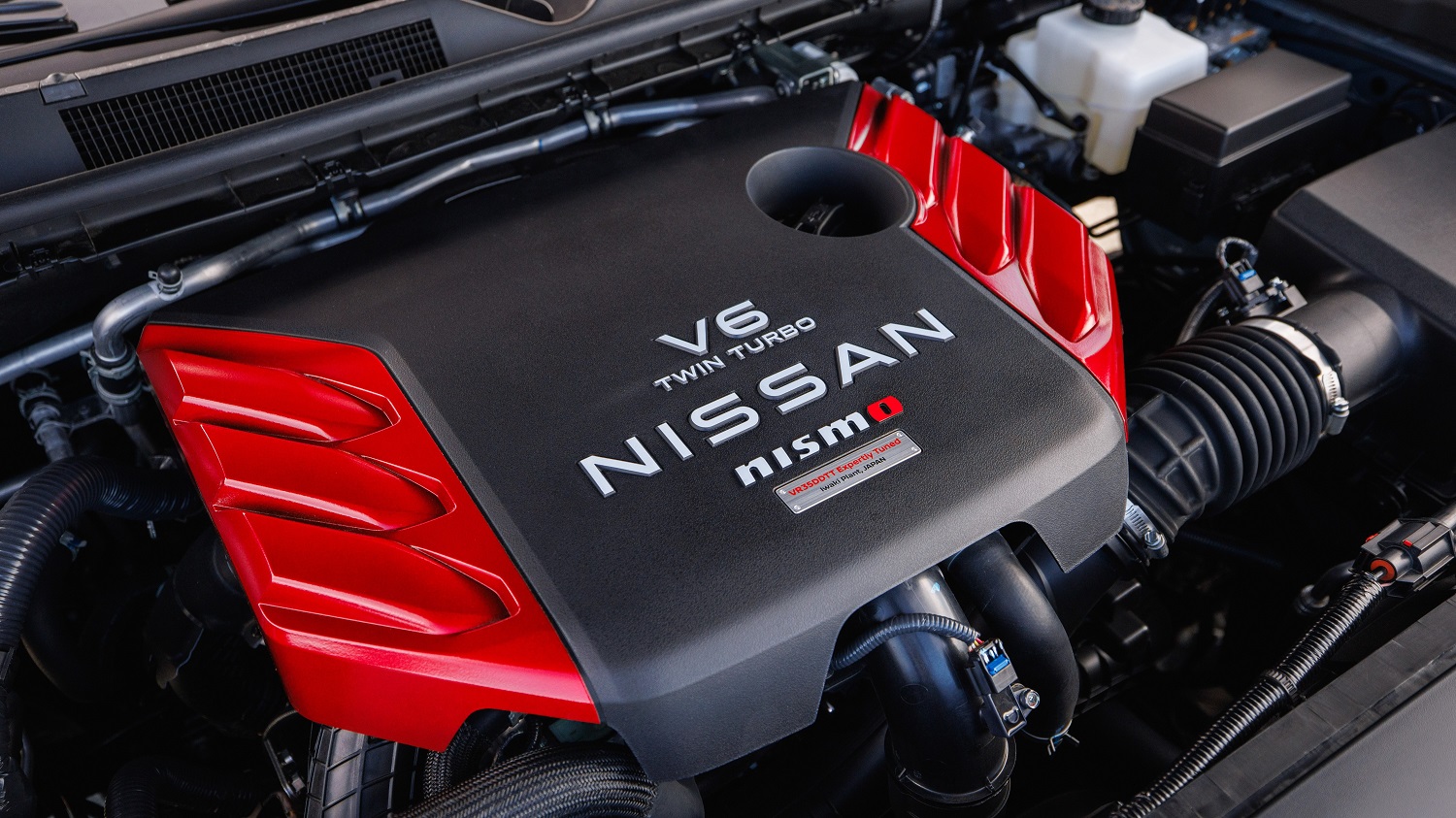
To make the Armada more capable in the curves, Nismo tunes the electric power steering and tweaks the Adaptive Electronic Air Suspension. Long straightaways can seem a little shorter thanks to revised engine programming and finely tuned valve clearances that bump the twin-turbo six’s output from 425 to 460 horsepower and 516 lb-ft of torque.
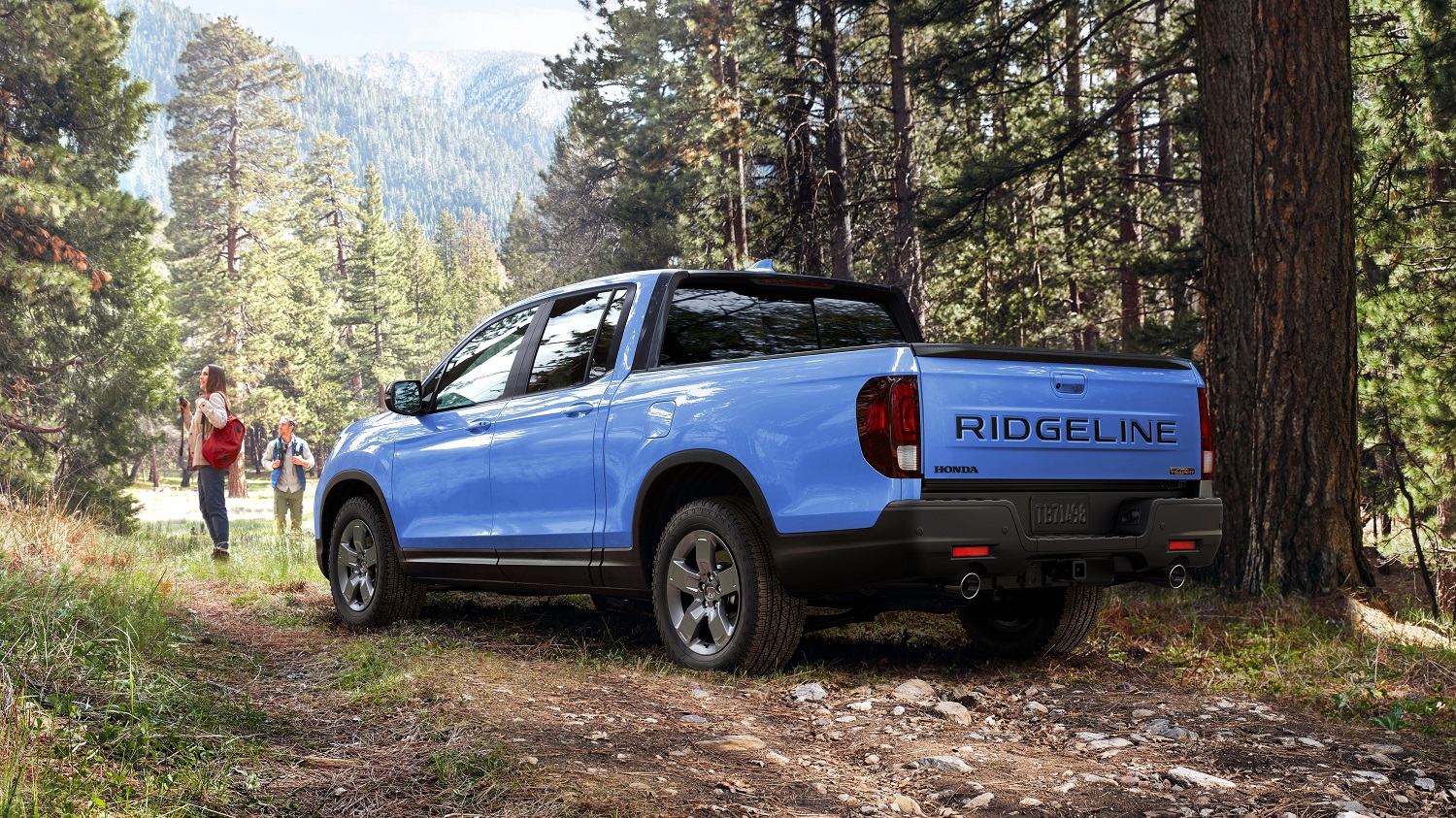
As odd as an Armada Nismo may seem, it’s not that surprising these days. It’s just part of manufacturers casting a wider net of specifically focused models to catch more buyers. Performance SUVs have been around for decades—remember the Mercedes-Benz ML55 AMG or the Porsche Cayenne Turbo from the 2000s? Several years ago, companies started pairing sports car-like performance with sleeker, coupe-like rooflines, which explains vehicles such as the BMW X6 and Genesis GV80 Coupe. Vehicles primarily meant for carrying people on paved roads suddenly started being offered in off-road trims with more rugged styling, all-terrain tires, and other upgrades to make them more capable in difficult terrain (which is where we tested the Honda Ridgeline TrailSport). Even certain EVs, such as the Hyundai Ioniq 5 XRT, are developed for fun in the dirt. That same general trend led to the 2025 Nissan Armada Pro-4X.
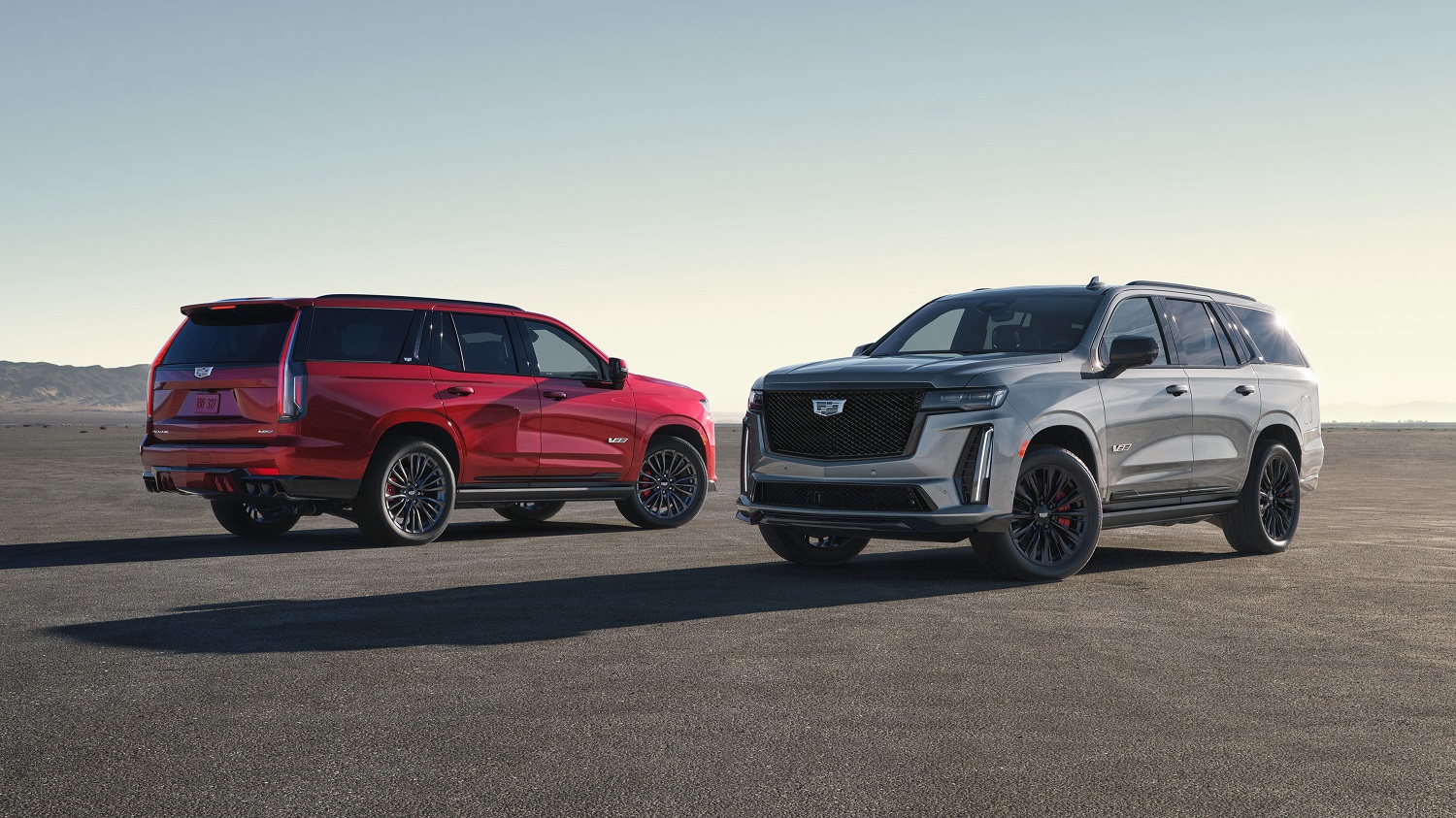
We’re also seeing larger SUVs shift toward the sportier end of the spectrum. For 2023, Cadillac released V versions of the Escalade and long-wheelbase Escalade ESV with 682 supercharged horsepower. We recently reviewed a Lexus TX 350 three-row SUV with the new-for-2025 F Sport Handling package, which shares space in the Lexus lineup with similarly equipped versions of the LX 600 and the LX 700h hybrid. Yes, on-road dexterity is now a priority for some buyers of the luxed-up Land Cruiser.
At this rate, maybe SUV convertibles are next. Were the Nissan Murano CrossCabriolet and the Land Rover Range Rover Evoque Convertible simply ahead of their times?
One of the rarest 1980s BMWs to find today is not an M car or even an Alpina—both of which have had a strong enthusiast audience from the time they were new. One of the most difficult-to-find 1980s BMWs is not a performance juggernaut either. It is instead the first diesel-powered BMW sold in the U.S.: the 524td. Today’s AutoHunter Spotlight is a 1985 BMW 524td located in Gladstone, Oregon.
The most interesting part of the 524td is, of course, the engine. The 2.4-liter inline-6 turbo-diesel engine called the M21 D24 was the brainchild of Karlheinz Lange from BMW’s engine development department. He saw what Mercedes was doing and found their diesel offerings unacceptable designs for a BMW. He also was convinced Munich engineers could produce something better than those in Stuttgart. A partnership between BMW and Steyr-Daimler-Puch gave BMW a new factory and development center from which the new diesel power plants could be designed and built. This M21 D24 engine utilized indirect “swirl chamber” injection (IDI), whereby fuel is sprayed into a small chamber above the combustion chamber, resulting in a much quieter diesel engine than what was offered by competitor Mercedes.
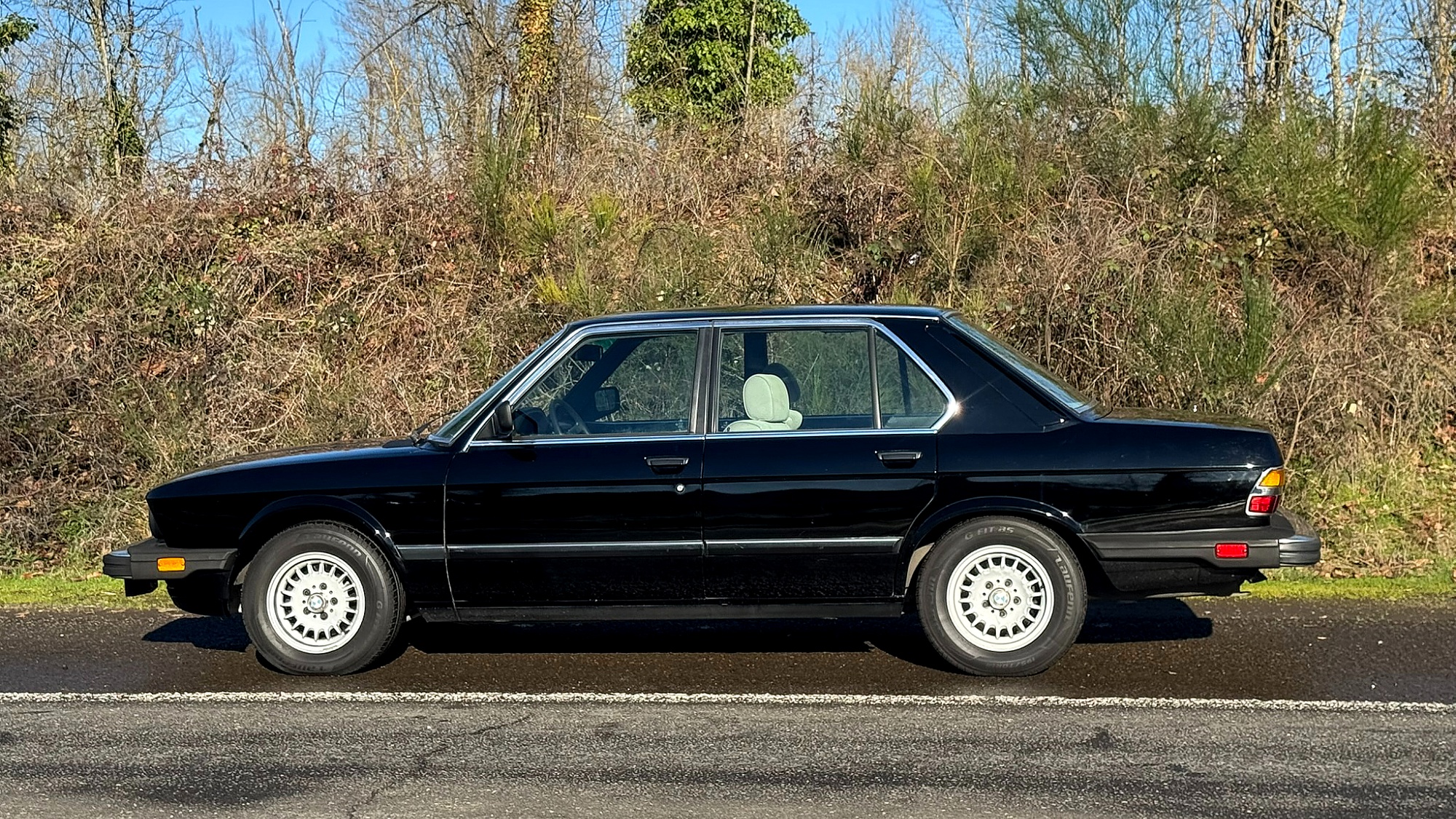
My dad had one of these cars when they were new. Unlike the clattery Mercedes diesel cars many of my friends’ parents had, the 524td was something different. Not only was it much quieter than almost any other diesel car, it also was equipped with the very sporty BMW E28 chassis. It even offered decent acceleration, with the turbocharged inline-6 diesel engine capable of a 0-60 time of 11 seconds—unheard of for a diesel sedan at the time. In addition, the 524td achieved close to 30 mpg. (An interesting historical note is that the short-lived Lincoln Mark VII diesel was actually powered by this same BMW diesel engine.)
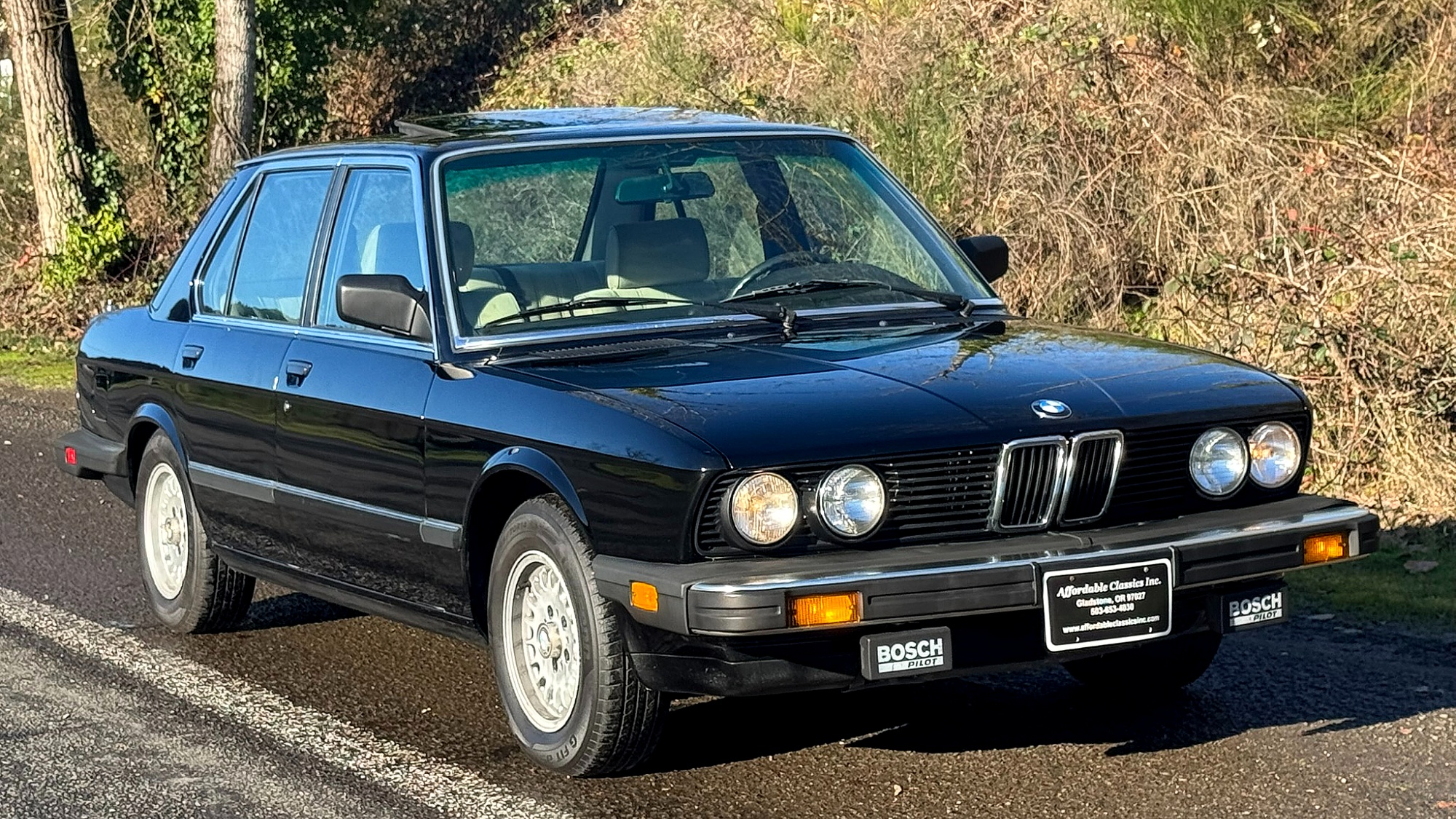
The seller describes this 524td as being powered by the aforementioned 2.4-liter inline-6 turbo-diesel, which is paired to a four-speed automatic transmission. Finished in black over a Pearl Beige cloth interior, this German sedan is offered by the selling dealer with a clean CARFAX report and clear title. It has clocked 121,000 miles, which is low for any diesel.
Many of these cars were literally driven into the ground, but this example looks to have lived a nice life. The exterior appears to be in exceptional condition, with nice paint and no evidence of any dents, rust, or other visible flaws. For a black car, this is kind of amazing—if it is a repaint, it is a good one, and if the car still has original paint, it is miraculous.
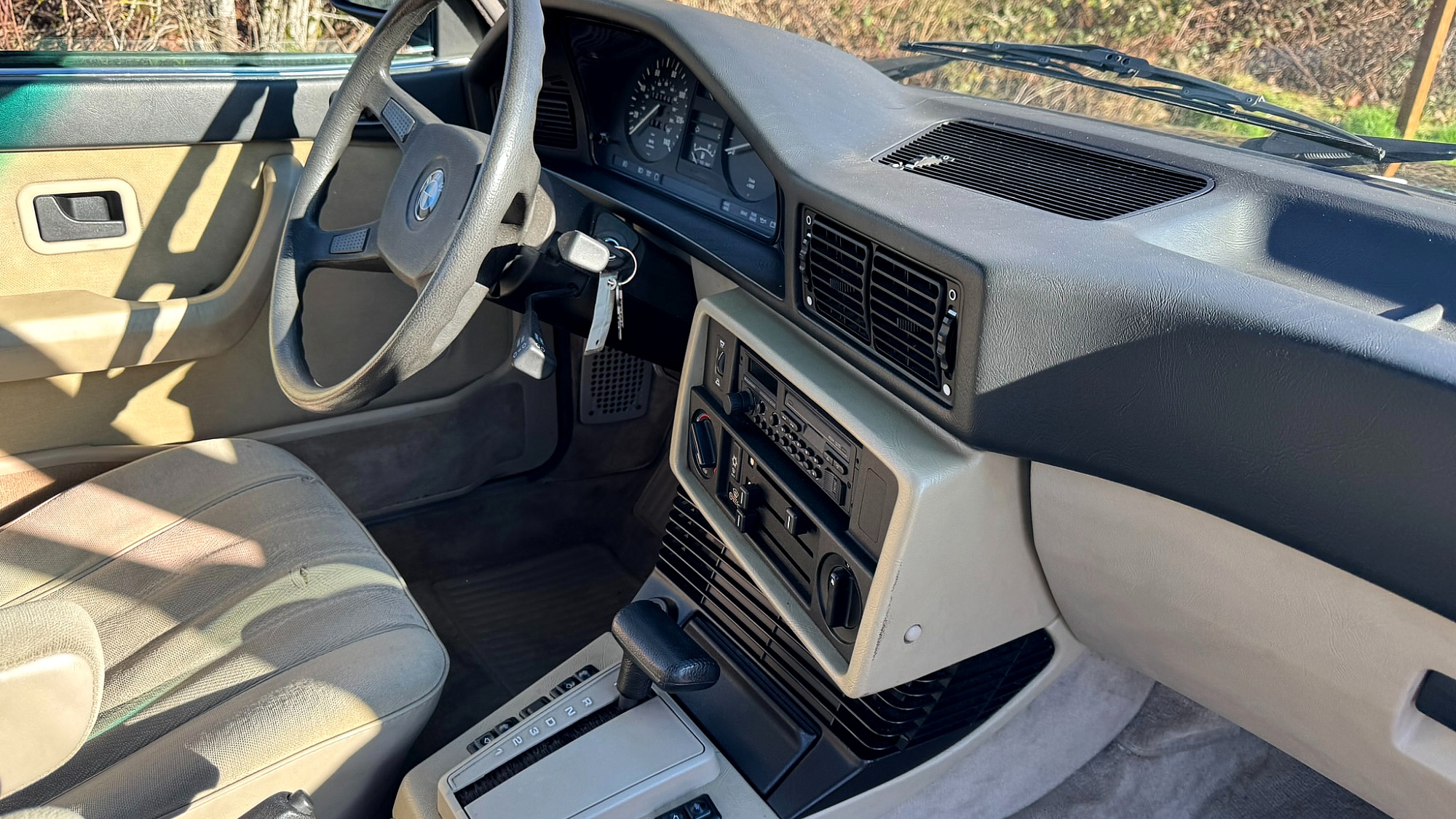
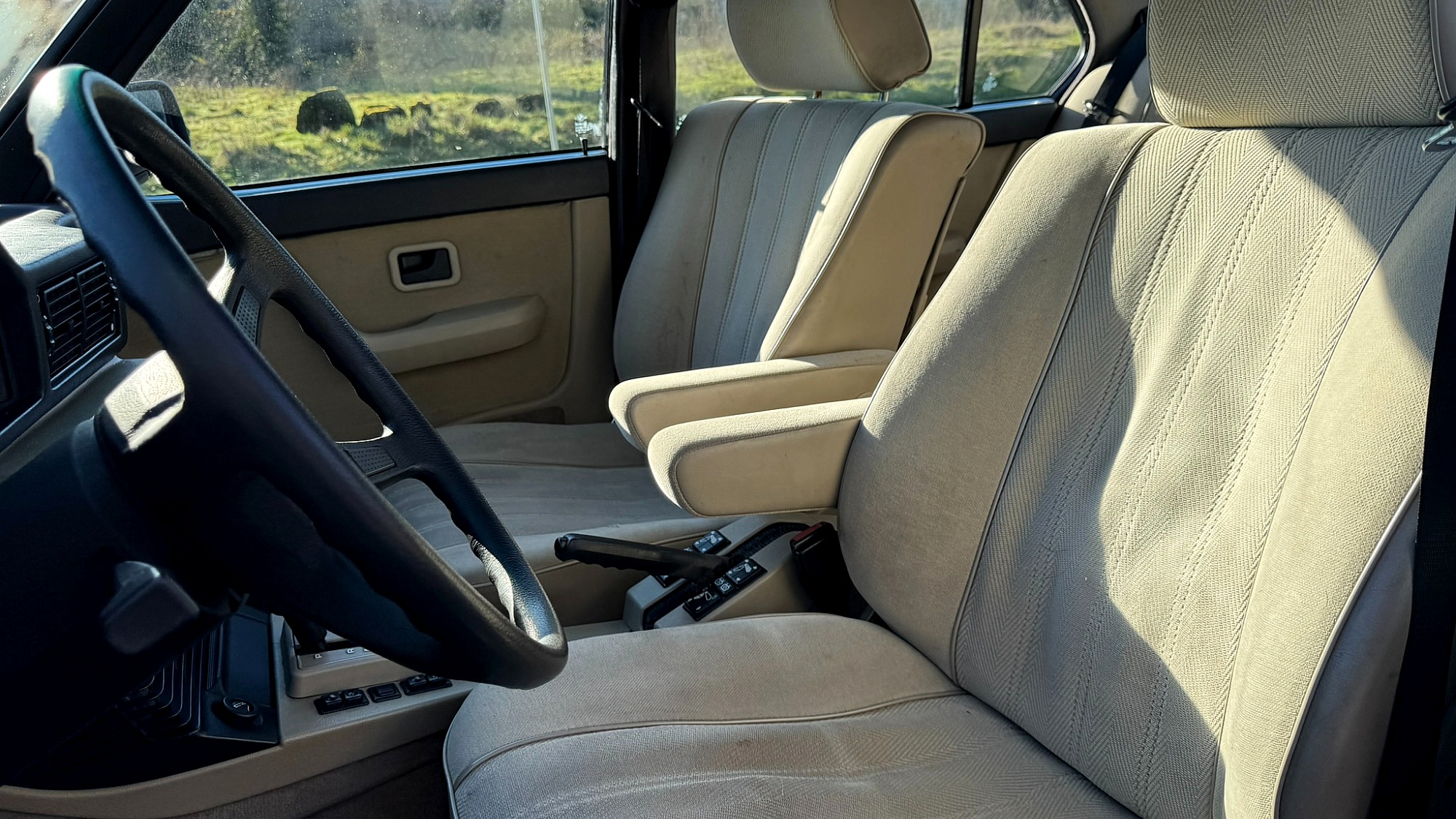
The interior is almost as good. The factory Ivory cloth seats are in unbelievable condition, with no rips or tears anywhere. They at best could use a little cleaning. The only interior flaws I could see in the photos were two small dash cracks on the driver’s-side near the windshield, and the sunroof needs new headliner cloth material. Options on this BMW include power seats, power windows, sunroof, cruise control, and air conditioning.
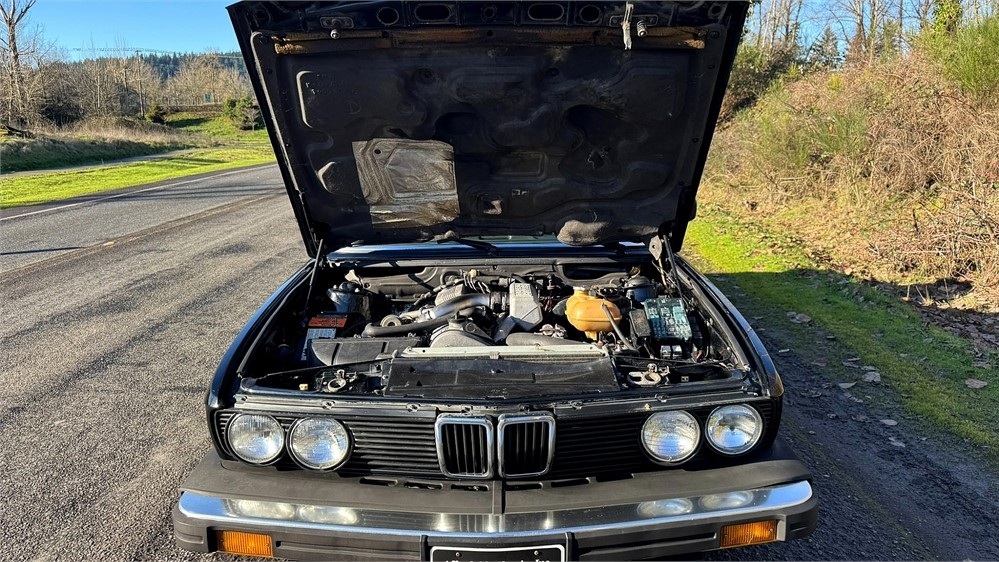
Under the hood everything also looks tidy; not detailed, but just clean. This really looks like a well-kept example. Recent service items include new vacuum hoses, heater fans, and belts in 2023, as well as a timing belt replacement in 2021.
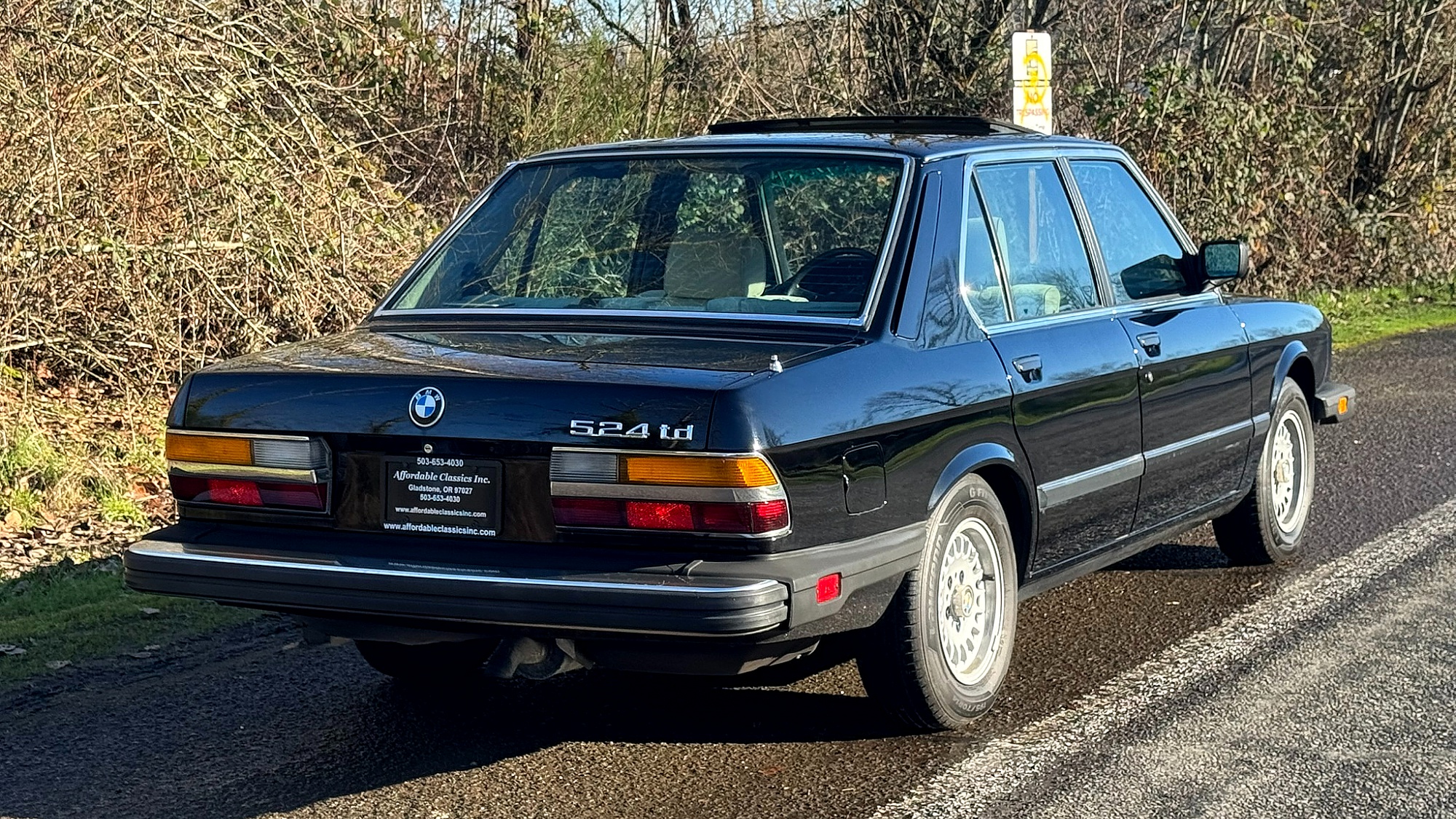
The 524td was one of the lowest-production BMW 5 Series cars in the E28 era. It was not a sales success—not because it was a bad car, as reviewers at the time sang its praises, but largely because BMW was late to the party with diesel power. Fast-forward to today, and diesel-powered BMWs are the most popular models in Europe. This rare car was the one that kicked it all off and is an important footnote in BMW history.
If you think this first-generation BMW diesel is as cool and unique as I do, you will need to act fast and bid, as the auction for this 1985 BMW 524td ends on Friday, August 1, at 12:30 p.m. (PDT).
Visit the AutoHunter listing for more information and a photo gallery
It’s hard to believe that vehicles from the late 1980s are old enough that some of them require restoration, but a lot can happen in nearly 40 years. That’s especially true for four-wheel-drive SUVs, many of which rack up loads of miles and/or get extensively modified and beat up off-road. It’s unclear what kind of life our Pick of the Day, a full-size 1989 Chevrolet Blazer V1500, led in the past, but we do know it has been fully restored, according to the dealer in Carrollton, Texas selling it on ClassicCars.com.
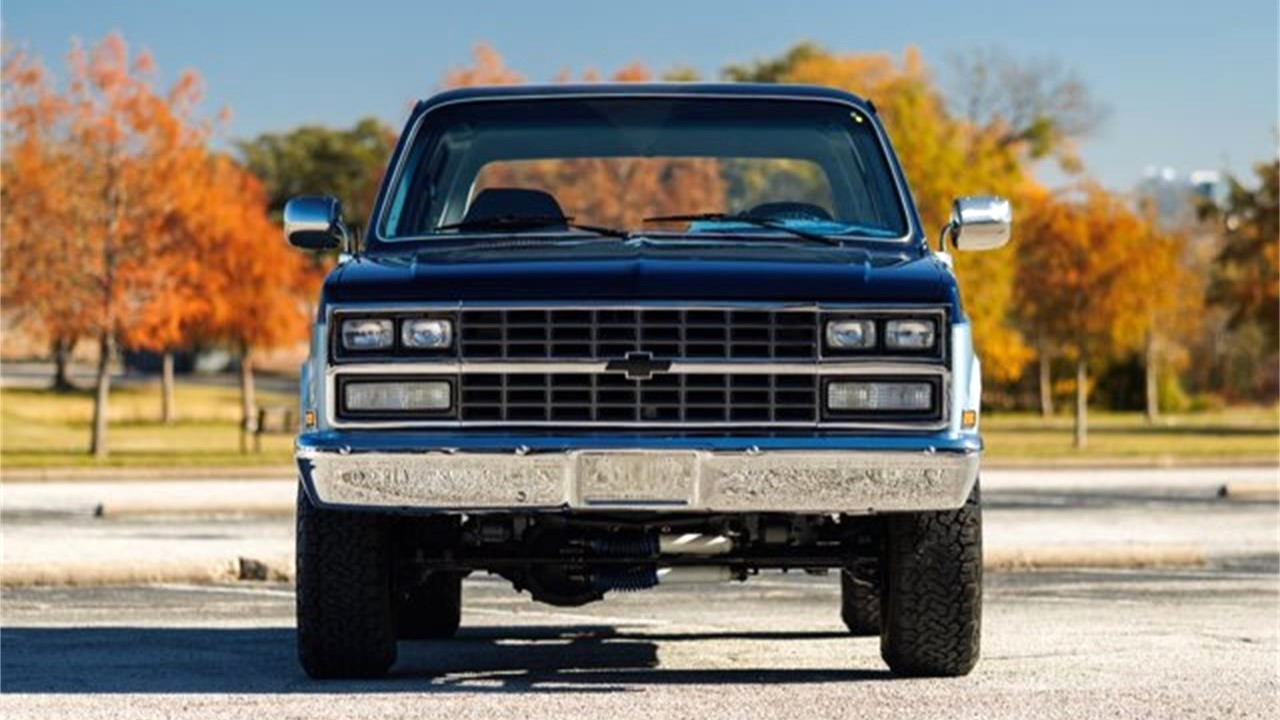
By 1989, the “Rounded Line” (aka “Square Body”) generation of the full-size Chevy Blazer was already more than 15 years old. It was also part of the R/V series of trucks and SUVs, which replaced the previous C/K naming structure a few years earlier. As part of a mild refresh, the ’89 Blazer received a redesigned grille, restyled side moldings, and a better paint job thanks to a new base-coat/clear-coat process. This particular Blazer has a new two-tone finish in factory colors, which appear to be Midnight Blue Metallic and Smoke Blue Metallic judging by the brochure. The Rally wheels are also new and come equipped with 31-inch BFGoodrich All-Terrain T/A tires, which are the right kind of rubber for such a rugged vehicle.
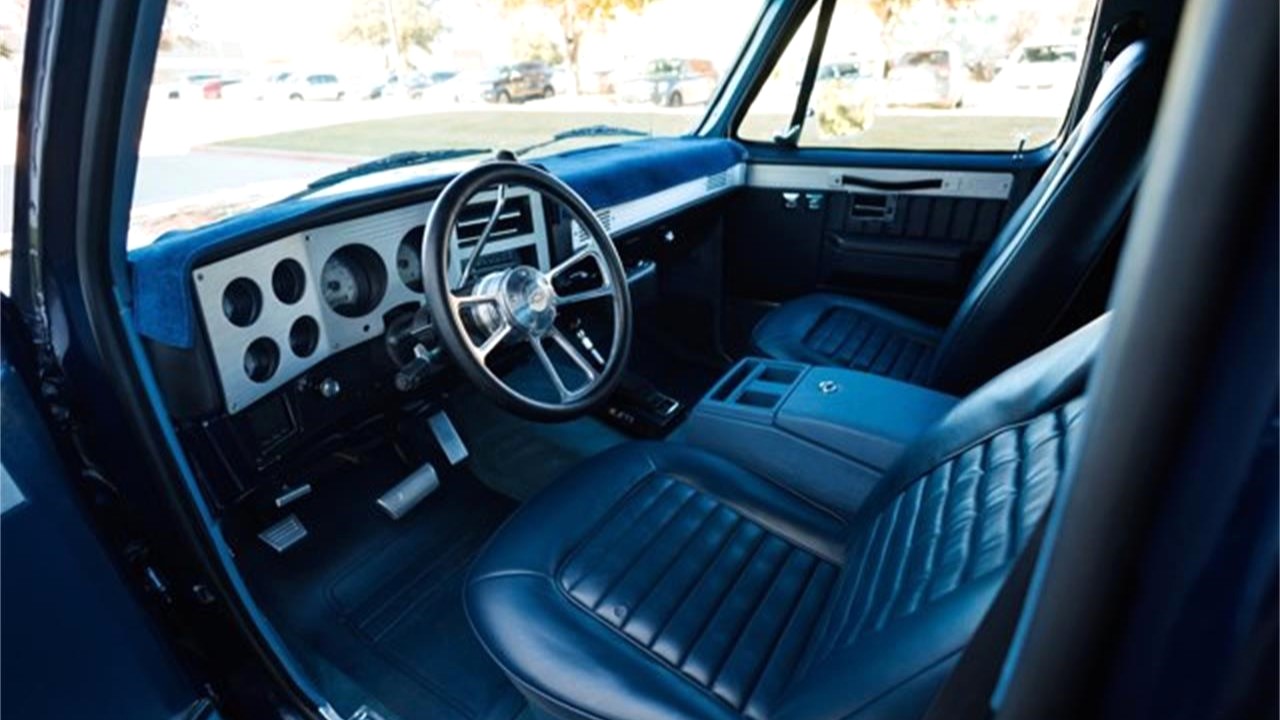
The most noticeable updates are inside. Behind the aftermarket steering wheel is a set of Dakota Digital gauges, which are surrounded by billet trim; the gas and brake pedals also get the billet treatment. Fresh blue leatherette covers the front buckets and rear bench seat. Cabin conveniences include power steering, power brakes, power locks and windows, air conditioning, and a locking center console with a pair of cup holders.
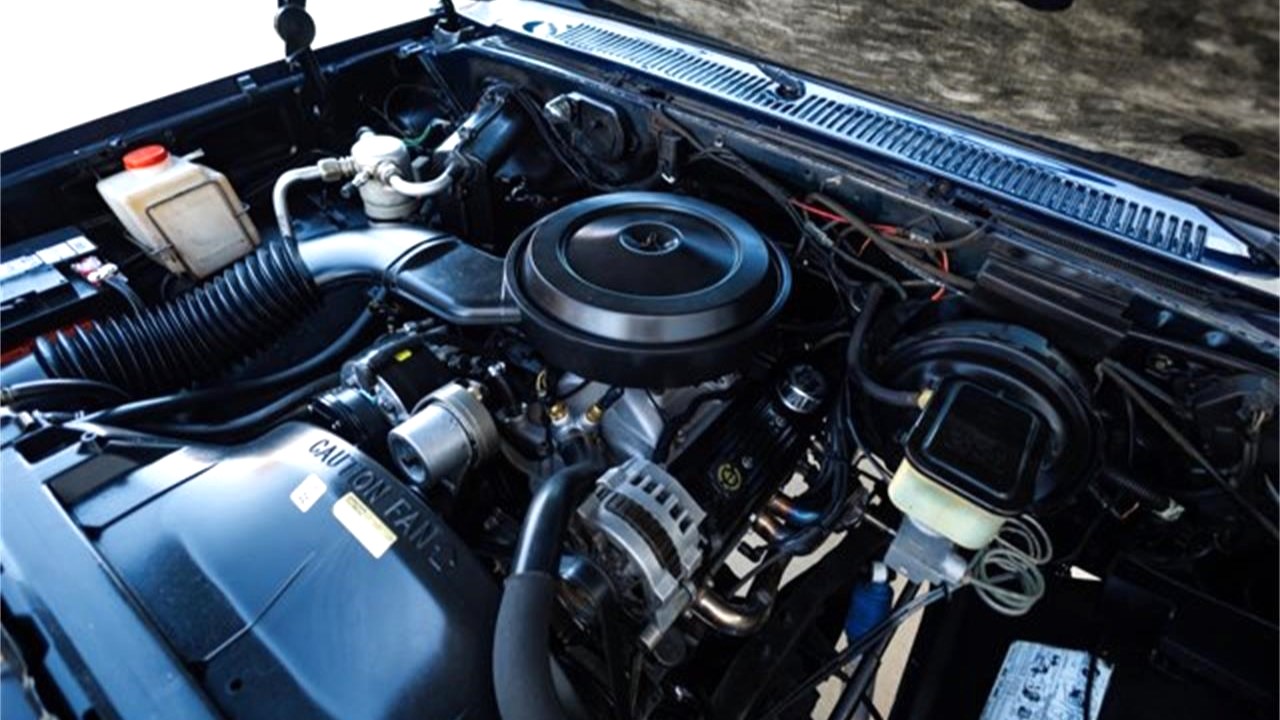
This full-size Blazer rolled off the production line with fuel injection but, interestingly, someone decided to retrofit its 350ci V8 with a 600-cfm four-barrel carburetor as well as a new exhaust system. That old-school-style power reaches the road or trail through a four-speed automatic and a dual-range transfer case.
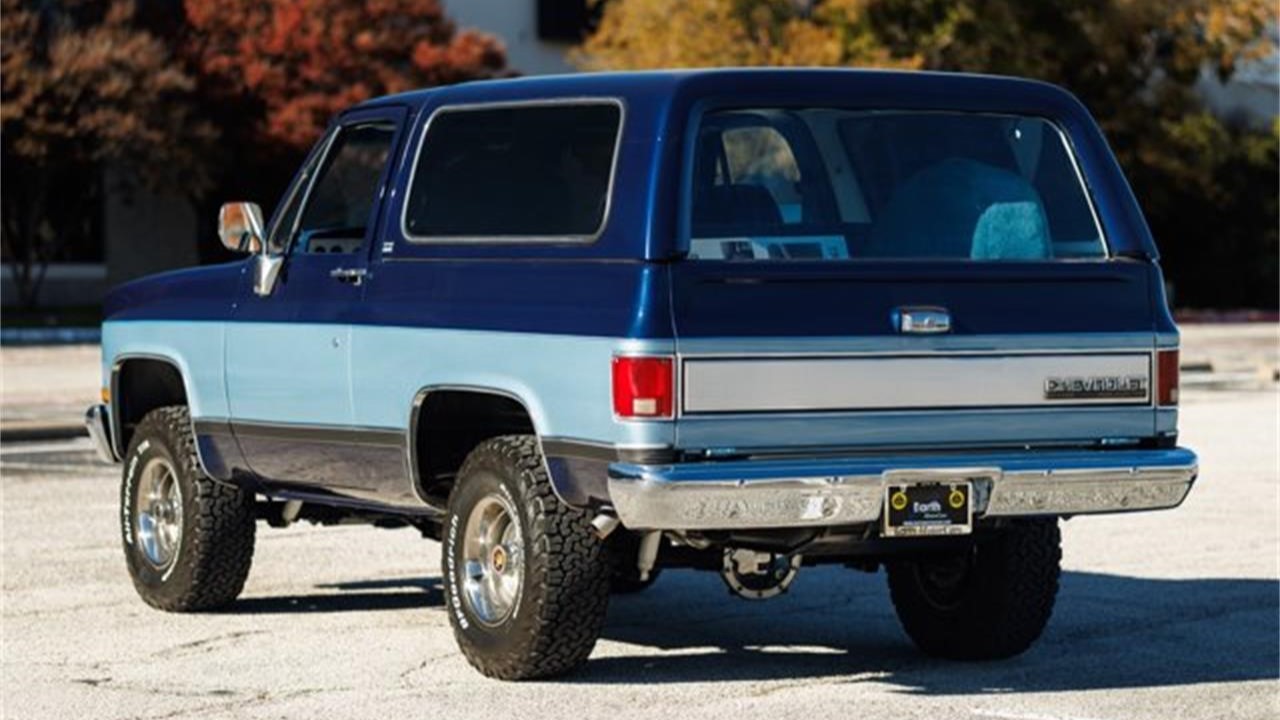
If you want a Square Body Blazer, there are three main ways you can get one. You can buy a Blazer that’s been driven into the ground, hunt for a fully original one with low miles, or purchase one that’s already received a ton of work and updates, such as this this 1989 Chevrolet Blazer V1500. If you choose to go that route, the first step in your journey to ownership will be paying the $49,900 asking price.
Click here to view this Pick of the Day on ClassicCars.com
This ’28 Ford Model A was built around 1999 using a steel Brookville body and steel fenders on a Total Cost Involved frame. It is powered by a 350ci V8 linked to a TH350 automatic transmission, and it has front disc brakes, a tubular front drop axle, a four-link rear setup with coilovers, and chromed 15″ wire wheels. In 2001 a Stayfast canvas top was installed along with a reupholstered bench seat. The car also features an Ididit tilt column, a banjo-style steering wheel, a dual exhaust system, a louvered hood, a rumble seat, wind wings, and Auto Meter gauges. Acquired by its current owner in 2002, this Model A is now offered at no reserve on dealer consignment with records and a clean California title listing the car as a 1928 Ford.

The build began with a donor 1928 Model A, and a replacement steel body from Brookville was mounted on a Total Cost Involved chassis. The black soft top is Stayfast canvas, and the hood is louvered. A replacement steel rumble seat lid, fenders, and doors were also mounted, and the bumpers and roll pan were replaced.

The 15×6″ and 15×7″ chromed wheels were sourced from Wheel Vintiques, and they are mounted with 185/60 and 235/70 Goodyear tires, respectively. The tubular dropped front axle is chromed and paired with a transverse leaf spring and radius rods, while out back is a TCI four-link setup with adjustable coilovers. A Vega steering box was also used.

The bench seat, door panels, and rumble seat upholstery were all done around 2001, at which time the carpeting was installed. The car also has wind wings and keyless ignition, and an Optima battery is secured in the rumble seat compartment.

The ’39-style banjo wheel is mounted on an Ididit tilt column. Auto Meter gauges were utilized, and 919 miles are indicated on the odometer.

As part of the build, a 350ci V8 with an Edelbrock aluminum intake manifold, a Holley carburetor, Mallory ignition, and coated ram’s horn manifolds was installed. The fuel lines are braided stainless-steel.

The TH350 automatic transmission is linked to a Ford 9″ rear end.

Records from the build are included.

The car is titled as a 1928 Ford using VIN LB3627, which the seller us unable to locate on the car. Images of the build in progress are provided in the gallery.
The automotive world is full of surprises. Some vehicles, initially dismissed as bland rental fodder or mere transportation appliances, have managed to carve out a place in history as true legends. Their stories reveal that greatness can emerge from the most unexpected origins.
Often overshadowed by flashier rivals, these cars were once overlooked by enthusiasts and critics alike. Yet, through unique engineering, devoted fan bases, or unexpected performance, they transcended their humble beginnings.
Their rise from obscurity to icon status proves that a car’s destiny isn’t written in stone—it’s forged by passion, ingenuity, and sometimes, a bit of luck.
There’s a distinct paradox in the world of car enthusiasts: some vehicles deliver unmatched driving joy but become nightmares the moment you have to live with them. These cars are exhilarating on the open road, sparking adrenaline and envy in equal measure. Yet, owning one often reveals a different reality—astronomical maintenance, insatiable thirst for fuel, and daily impracticalities.
For many, the allure of these machines is irresistible, but the headaches they bring are just as legendary.
This article dives into 17 of the most thrilling cars that, for all their excitement, are best enjoyed from the driver’s seat—without the burden of ownership.
Step into a dealership, and you’ll find cars engineered to dazzle from the moment you turn the key. Bold styling, punchy acceleration, and cutting-edge tech often steal the spotlight during a quick test drive.
These vehicles are designed to make buyers fall in love instantly, masking potential flaws that emerge only with time.
However, what feels thrilling in a 20-minute spin around the block can unravel as costly repairs, uncomfortable rides, or disappointing resale values down the road.
As Consumer Reports points out, the real test is how a car holds up after the honeymoon phase.
It’s never too late for someone to be reunited with a memorable car from their past. Zachary, a friend from Ohio, recently shared a story on Facebook about how he found, restored and presented a 1958 Chevrolet to his 86-year-old great-grandfather. The special occasion is something I wanted to share with our audience at The Journal.
Zachary gives some backstory: “Poppie (Michael) is my great-grandfather, born in 1939. He married Gram in July 1958, and she passed away from cancer on January 4, 2011. Poppie is my best friend and biggest inspiration in life. He took me in full-time when I was 14. He’s always gone above and beyond for everyone around him – making sacrifice after sacrifice and going out of his way for others. He’s the reason I’m the man I am today and why I’ve been able to succeed in my short 25 years.”
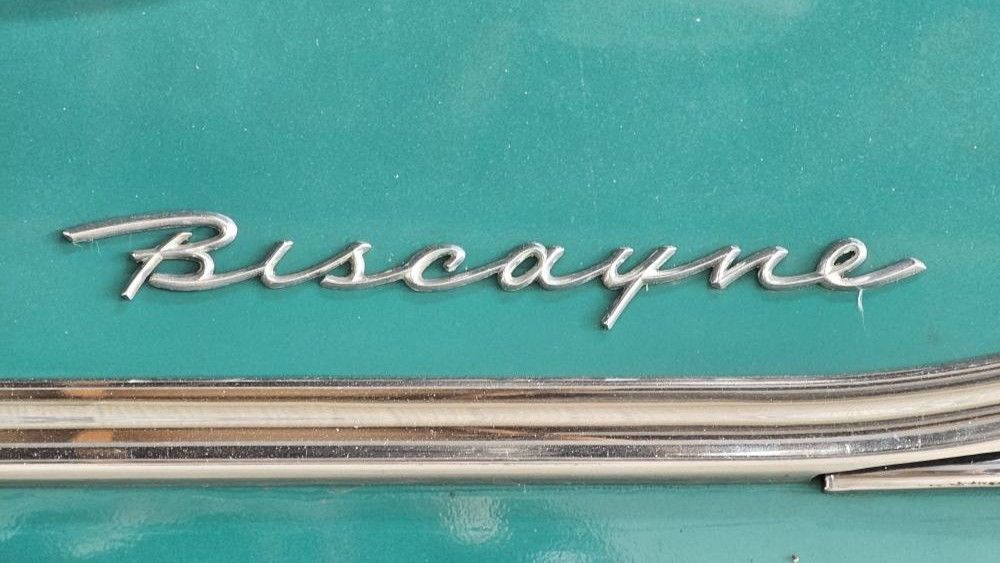
Biscayne Backstory
Regarding the Biscayne, it was a full-sized car produced from 1958 through 1972. Throughout its lifespan of five generations, it shared engineering at one time or another with cars like the Bel Air, Caprice, Del Ray, and Impala. The Biscayne was slotted toward the lower end of the price bracket – especially when it came to full-sized cars. Advertisements for the 1958 Chevrolets said, “You’ll like being looked at in your ’58 Chevrolet. There’s a special kind of glow that goes with owning a new Chevrolet. Behind the wheel, you feel like you’re right where you belong.”
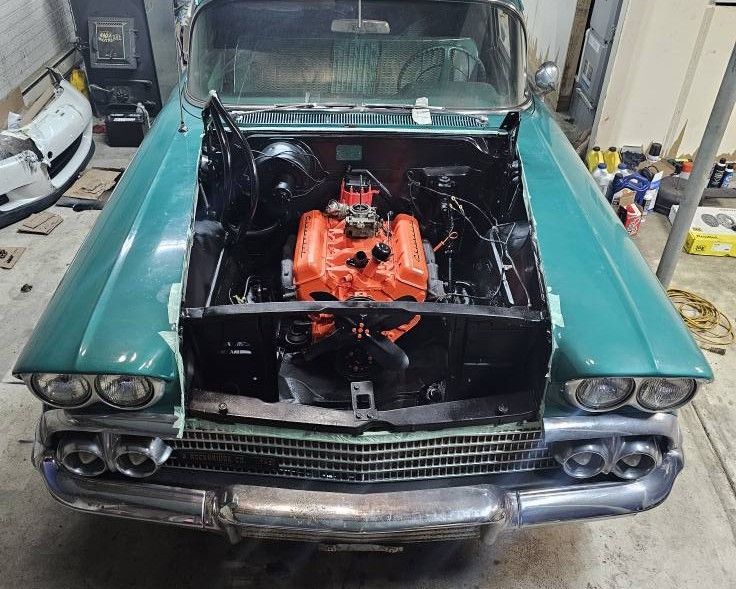
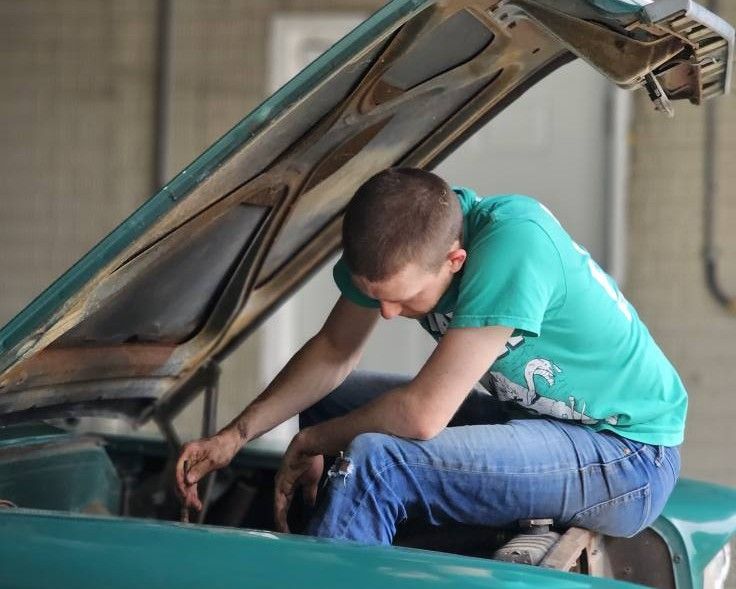
A Man on a Mission
And, as it turns out, the driver’s seat of a Biscayne is exactly where Poppie belongs. The green four-door Biscayne that Zachary fixed up for his great-grandfather went through a comprehensive mechanical and cosmetic overhaul within the last couple of months, and on Wednesday, July 23, the car was presented as a surprise to Poppie.
Zachary narrates: “July 23, 2025, will go down as the happiest day of my life. On what would have been Gram and Poppie’s 67th anniversary, we got to make his dream of owning another 1958 Chevrolet Biscayne come true. In 25 years, this is only the fourth time I’ve ever seen the old man cry. The words ‘This is my favorite ever car,’ couldn’t be truer.”
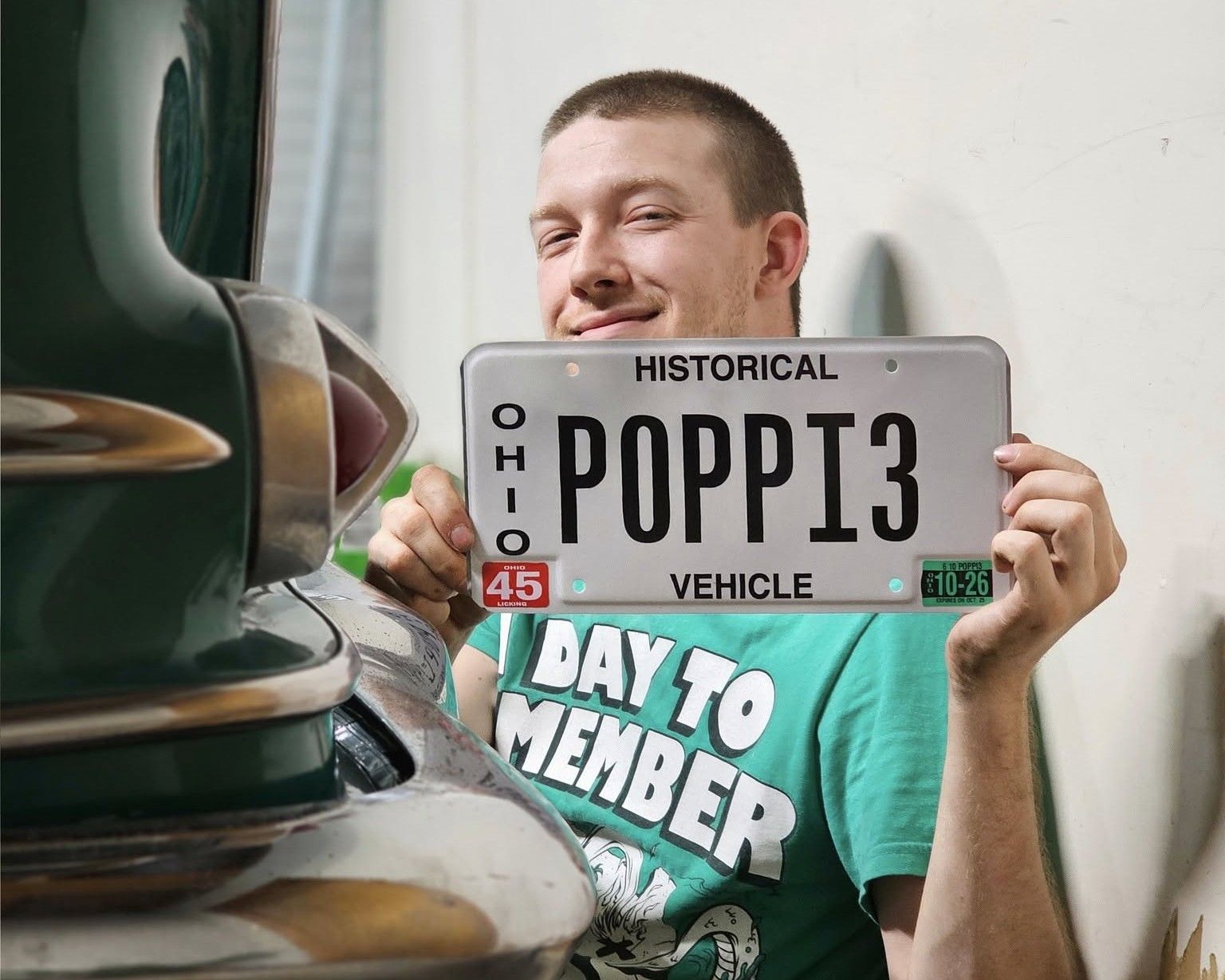
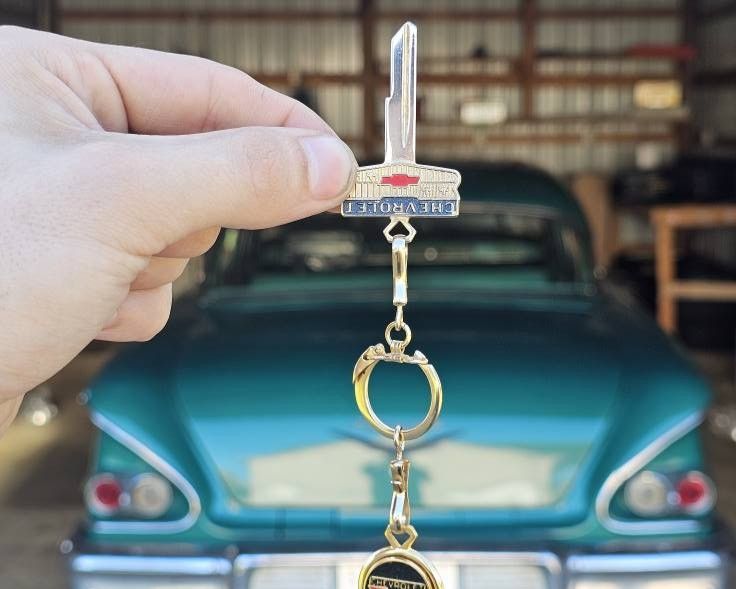
He continues, “Poppie speaks often about his ‘58 that he loved so dearly. Even in his times of darkness, talks of the ‘58 always brought smiles and laughter. For 10 years I’ve dreamed of making this day a reality, and here it is. We have broken our bodies over the last two months, restoring this Biscayne and getting her running again. She fought us hard, begging to remain in a state of rest; but we had other plans for her. The 283ci V8 got a full overhaul with new valves, lifters and a bigger cam. She got fresh paint and a bundle of love.”
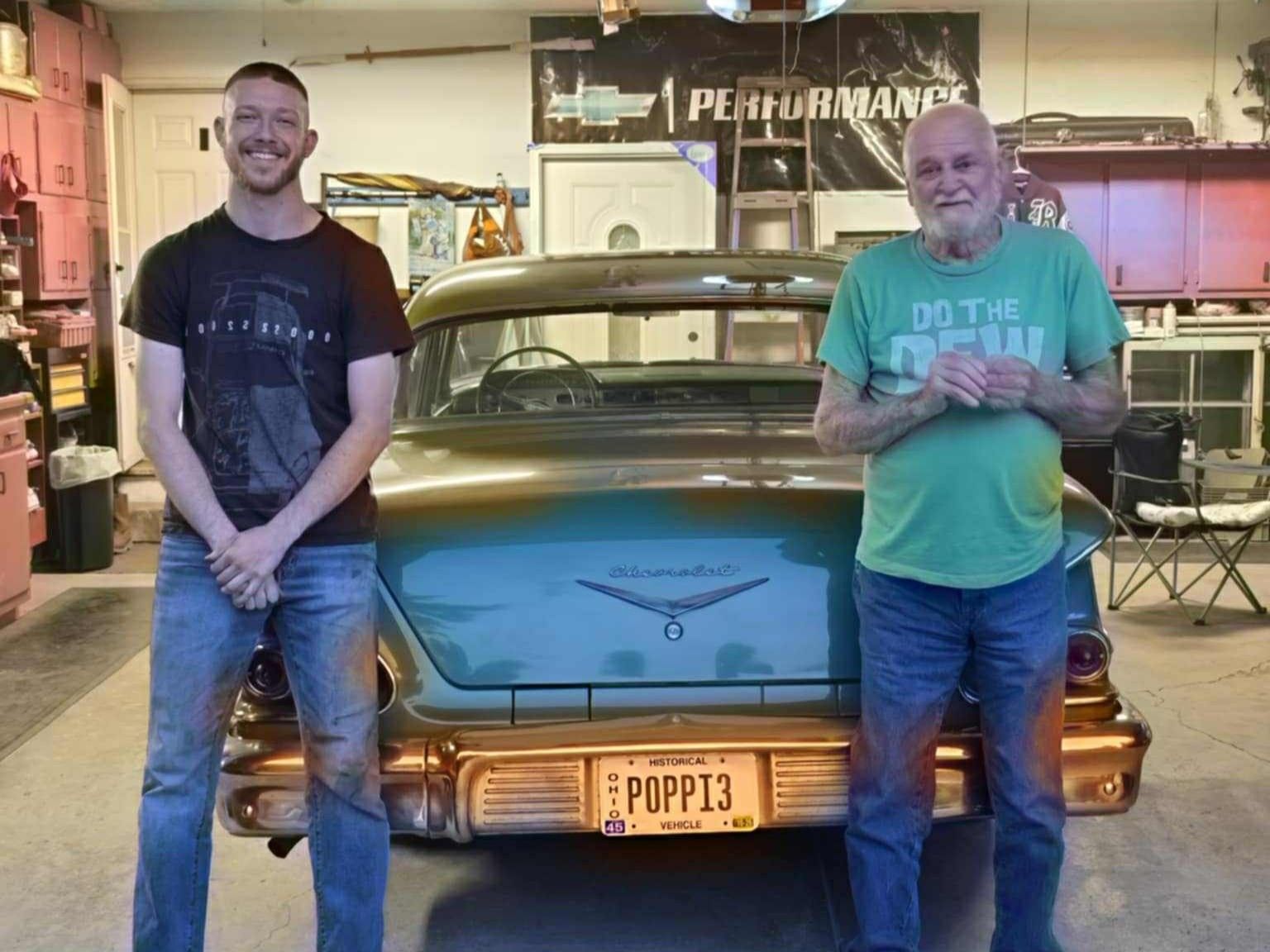
Dreams Come True
Zachary talks about Honda’s famous slogan, “The Power of Dreams.” Being able to give Poppie a 1958 Biscayne was the fulfillment of a long-time dream. He says, “To the memories going forward, the car shows and the Sunday cruises. My heart is full, and my love is absolute.”
Congratulations, Poppie!
